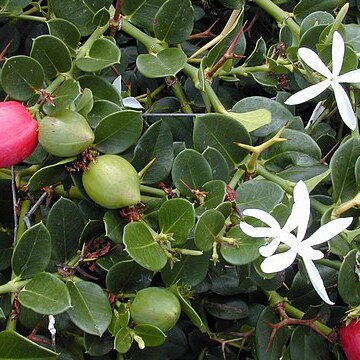Much branched shrubs, sometimes scandent, with simple or forked spines; stipules absent. Leaves opposite, petiolate; blade ovate to suborbicular, with or without a mucro at the apex, entire or slightly crenate at the margin. Inflorescence a terminal corymb or cyme, dense to lax. Flowers 5-rarely 4-merous, fragrant. Sepals imbricate. Corolla pink outside, white inside; tube cylindrical; lobes contorted, overlapping to the left or right. Stamens included, free from the style, inserted at the middle or towards the apex of the corolla tube. Ovary glabrous, 2-celled, with 1–4 or rarely many ovules per locule; style terete; pistil head of two parts, a subglobose or ellipsoid basal stigmatic part and a bilobed stigmoid apex. Fruit an ellipsoid or ovoid berry with 1–8 seeds.
Shrubs, small trees or lianas. Branches bearing sharp spines, spines either simple or branched. Leaves opposite, those of a pair equal, usually with few secondary veins; colleters in axils few or absent. Inflorescence a terminal and/or axillary cyme, usually few-flowered; flowers 5-merous. Sepals without colleters inside. Corolla lobes dextrorse in bud (or sinistrorse in some African species); mature flower salverform with a narrow tube and spreading lobes. Stamens completely included in the corolla tube; filaments short and filiform; anthers ovate to oblong, fertile entire length, free from the style head. Disk absent. Gynoecium syncarpous, bilocular, each locule with 2 ovules; style filiform. Fruit a fleshy berry; 4-seeded. Seeds flattened, ellipsoid.
Shrubs, climbers, or small trees, mostly spiny. Branches dichotomous. Leaves opposite; petiole 2-3 mm. Cymes terminal or axillary, dichotomous, pedunculate, usually many flowered. Flowers 5-[or 4]-merous. Calyx without glands or rarely with many basal glands inside. Corolla salverform, tube cylindric, dilated at staminal insertion, lobes overlapping to left or to right. Stamens included in throat; anthers lanceolate, obtuse or apiculate, base not appendaged; disc absent. Ovary 2-loculed; ovules 1-4 in each locule, rarely numerous, biseriate. Style filiform; pistil head narrowly oblong or fusiform, apex shortly 2-cleft. Berries 1-or 2-loculed. Seeds 2 or more, peltate; endosperm fleshy; cotyledons ovate, radicle inferior.
Corolla hypocrateriform; tube cylindrical, ± straight, hairy within; lobes contorted, overlapping either to the left or the right, of various shapes, much shorter than to longer than the tube.
Ovary glabrous, bicarpellate, with 1–4 or rarely many ovules per loculus; style slender; stigma below or reaching to androecium, bilobed, glabrous; clavuncle often inconspicuous.
Stamens inserted at the middle or towards the top of the corolla tube; anthers subsessile, without carina, glabrous.
Shrubs or small trees, much branched, sometimes scandent, with simple or forked spines.
Fruit an ellipsoid or ovoid berry containing (l)2–8(8) seeds.
Seeds discoid or compressed-ellipsoid, velutinous.
Flowers in terminal corymbs or 1–5-flowered cymes.
Calyx lobes imbricate, free to base.
Stipules absent.

